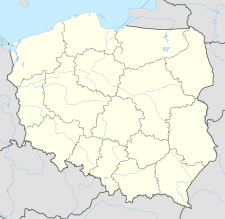| Maria Sklodowska-Curie National Research Institute of Oncology | |
|---|---|
| Polish Ministry of Health | |
 Maria Skłodowska-Curie Institute Maria Skłodowska-Curie Institute | |
  | |
| Geography | |
| Location | Warsaw, Masovian Voivodeship, Poland |
| Coordinates | 52°8′51″N 21°1′57″E / 52.14750°N 21.03250°E / 52.14750; 21.03250 |
| Organisation | |
| Type | Specialist |
| Services | |
| Beds | 741 |
| Speciality | Oncology |
| History | |
| Opened | 29 May 1932 |
| Links | |
| Website | www |
The Maria Sklodowska-Curie National Research Institute of Oncology (Polish: Narodowy Instytut Onkologii im. Marii Skłodowskiej-Curie – Państwowy Instytut Badawczy, until 2020 Maria Skłodowska-Curie Institute of Oncology, Polish: Centrum Onkologii–Instytut im. Marii Skłodowskiej-Curie) is a specialized research institute and hospital of the Polish Ministry of Health. Based in Warsaw, it also has regional branches in Gliwice and Kraków. It was founded in 1932 as the Radium Institute by double-Nobel laureate Maria Skłodowska-Curie in collaboration with the Polish Government, especially President Ignacy Mościcki.
History
The institute was created in 1925 following the success of the first Radium Institute, which had been set up in 1918 by Maria Skłodowska-Curie at the University of Paris. While Maria toured the United States to raise funds, receiving the gift of a gram of radium from US President Herbert Hoover that had been bought with funds raised by American women, her sister Bronisława Dłuska supervised fundraising in Poland and oversaw the construction and recruitment, organising a campaign that sold symbolic bricks featuring Maria's image. It was officially opened on 29 May 1932, with Bronisława continuing as the director. One of the institute's brick walls bears the inscription, "MARII SKŁODOWSKIEJ CURIE, W HOŁDZIE"—"In homage to Maria Skłodowska Curie."
In August 1944, during the Ochota massacre that followed the Warsaw Uprising, the patients and the staff were brutally murdered by the members of S.S. Sturmbrigade R.O.N.A. anti-partisan formation, and the building looted and set on fire.
After World War II, the Institute re-opened and changed its name to "Maria Skłodowska-Curie Institute of Oncology", developing into a specialized research institute and hospital of the Polish Ministry of Health, and opening regional branches in Gliwice and Kraków. It is now the leading and most specialized cancer research and treatment center in Poland.
In May 2013, the institute was brought to international attention when it performed a full face transplant on a man who had been in an industrial accident just a few weeks prior. Just a few months later, they completed a face transplant on a woman who had been disfigured by tumor to the point the she could not eat or talk without great difficulty.
See also
References
- "Statut Narodowego Instytutu Onkologii im. Marii Skłodowskiej-Curie - Państwowego Instytutu Badawczego". Archived from the original on 2023-03-06. Retrieved 2020-04-04.
- Pasachoff, Naomi (2000). "The Radium Institute (1919–1934)". Marie Curie and the Science of Radioactivity. American Institute of Physics. Archived from the original on 10 July 2015. Retrieved 13 September 2015.
- ^ Podogrocka, Ewa. "Bronisława Dłuska". Unlearned Lessons. Archived from the original on 1 April 2018. Retrieved 13 September 2015.
- Skwarzec, Bogdan (March 2011). "Maria Skłodowska-Curie (1867–1934)—her life and discoveries" (PDF). Anal Bioanal Chem. 400 (Special issue: Radioanalytics—Dedicated to Marie Skłodowska-Curie): 1547–1554. doi:10.1007/s00216-011-4771-3. PMID 21390567. S2CID 40787185. Archived from the original (PDF) on 4 March 2016.
- "Polish woman undergoes full face transplant". NY Daily News. Associated Press. 13 December 2013. Archived from the original on 27 February 2018. Retrieved 13 September 2015.
External links
| Ursynów, Warsaw | ||
|---|---|---|
| Neighbourhoods |  | |
| Parks | ||
| Education and science | ||
| Sports | ||
| Religion | ||
| Culture | ||
| Other buildings | ||
| Transport | ||
| Roads | ||
| Geography |
| |
| Marie and Pierre Curie | |
|---|---|
| Discoveries | |
| Publications | |
| Museums | |
| Family |
|
| Namesakes | |
| Depictions |
|